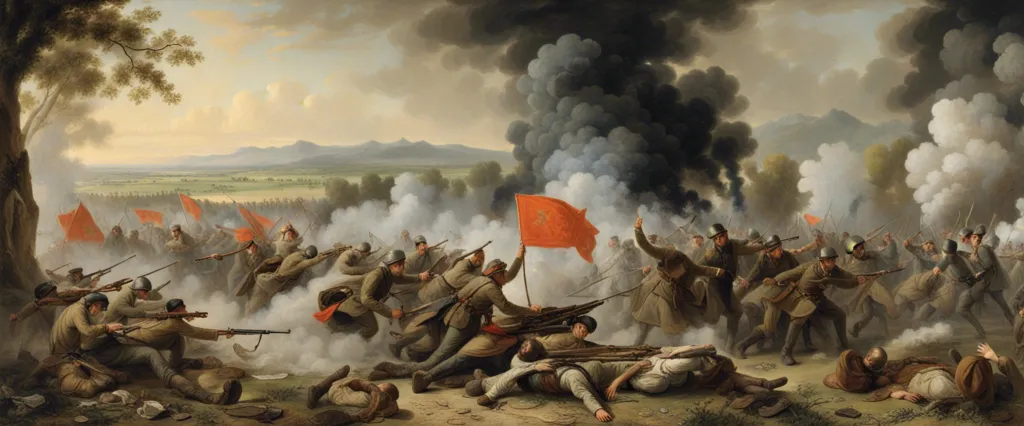
In the vast world of literature, certain books manage to etch themselves into the annals of history, leaving an enduring legacy for generations to come. Leo Tolstoy’s War and Peace and Margaret Mitchell’s Gone With the Wind are two such masterpieces that have captivated readers for decades. These epic novels, set against the backdrop of turbulent times, provide intricate portrayals of human emotions, societal transformations, and the resilience of the human spirit. While distinct in their settings, characters, and thematic explorations, these novels share a common thread of portraying the impacts of war on individuals and societies. This comparative study aims to delve into the depth and breadth of these literary treasures, analyzing their unique attributes while drawing insightful connections between the worlds created by Tolstoy and Mitchell.
At first glance, it may appear that War and Peace and Gone With the Wind occupy different corners of the literary spectrum due to their geographical and temporal disparities. War and Peace takes place in early 19th century Russia, chronicling the upheavals caused by the Napoleonic Wars. In contrast, Gone With the Wind unfolds in the antebellum South, amidst the American Civil War. Despite these differences, both novels offer remarkable insights into the effects of war on individual lives, families, and entire societies. Through their intricate character developments and vivid narrative styles, Tolstoy and Mitchell each paint a vivid picture of how war weaves its profound influence on the human experience.
Furthermore, exploring the central characters in both novels uncovers fascinating intersections and divergences. War and Peace introduces readers to a rich ensemble cast, including Pierre Bezukhov, Prince Andrei Bolkonsky, and Natasha Rostova. These characters grapple with existential questions, forming profound emotional connections and enduring personal transformations as they navigate the chaos of war. On the other hand, Gone With the Wind revolves around Scarlett O’Hara, a headstrong Southern belle, and Rhett Butler, a mysterious and intriguing outsider. The examination of Scarlett’s resilience, ambition, and tenacity amidst the devastation of war serves as a parallel to the characters in War and Peace and raises intriguing questions about the ways in which individuals respond to conflict and adversity.
Beyond the characters, both Tolstoy and Mitchell intricately weave historical events into the fabric of their narratives. Tolstoy’s meticulous portrayal of the Napoleonic Wars grants readers an expansive understanding, not only of the military campaigns, but also of the nuanced ways in which war reshapes political power, cultural norms, and societal hierarchies. Similarly, Mitchell’s meticulous historical research enables readers to experience the shifting fortunes and cultural transformations of the Old South, illuminating the profound consequences of the Civil War on the plantation-owning families and enslaved individuals.
As we embark on this comparative journey through the pages of War and Peace and Gone With the Wind, we will explore the ways in which Tolstoy and Mitchell internalize and externalize war’s multifaceted effects. Through their unique narrative styles and compelling plotlines, these literary marvels will enlighten us on the triumphs, tragedies, and enduring consequences wrought by warfare. By examining the societal, political, and psychological dimensions of these novels, we hope to gain a deeper appreciation of the intricate tapestries woven by Tolstoy and Mitchell, and the profound impact of war on the human condition.
Brief Summary of Two Books
War and Peace by Leo Tolstoy
War and Peace is a historical novel written by Leo Tolstoy, set in Russia during the Napoleonic era. The story follows several characters and intertwines their lives over a period of about fifteen years, particularly focusing on their experiences during the French invasion of Russia in 1812. The novel revolves around themes such as war, love, destiny, and the meaning of life.
The plot primarily focuses on five aristocratic families: the Bezukhovs, the Rostovs, the Bolkonskys, the Kuragins, and the Drubetskoys. Among the main characters are Pierre Bezukhov, a kind-hearted but confused young man who gains unexpected wealth and tries to find his purpose in life; Prince Andrei Bolkonsky, a disillusioned nobleman longing for glory and intellectual pursuits; and Natasha Rostova, a vivacious young woman navigating love and societal expectations.
As the novel progresses, Tolstoy depicts the tumultuous events of the Napoleonic Wars and explores the impact of historical events on individual lives. The peace sections of the novel delve into the characters’ personal lives, relationships, and philosophical musings, while the war sections portray the chaos and horror of battle.
Throughout War and Peace, Tolstoy offers deep insights into the human condition, contrasting human agency with the role of fate or historical determinism. The characters grapple with love, loss, and the pursuit of happiness, ultimately questioning the existence of free will and seeking a sense of purpose in life. Tolstoy delves into the lives of different social classes, military leaders, and peasants, bringing together a vast panorama of Russian society during this period.
War and Peace is not only a gripping historical narrative but also a philosophical exploration of human nature, morality, and the larger forces that shape our lives.
Gone With the Wind by Margaret Mitchell
Gone With the Wind” by Margaret Mitchell is an epic historical novel set in the American South during the Civil War and Reconstruction era. The story follows Scarlett O’Hara, a headstrong and determined young woman from a wealthy Southern plantation who experiences personal and societal turmoil as the war ravages through her life.
Scarlett, initially infatuated with the charming Ashley Wilkes, finds herself in constant conflict with the charismatic Rhett Butler, a scandalous yet charming rogue who is both fascinated and frustrated by her. Despite her feelings for Ashley, Scarlett marries his cousin, Charles Hamilton, in an effort to secure her status and wealth. However, her plans are disrupted when Charles dies during the war, leaving her a widow.
As the war progresses, Scarlett’s world is consumed by fear, poverty, and the fight for survival. She adapts to the changing times by becoming a shrewd businesswoman and manipulates situations to her advantage, even if it means sacrificing her morals. Throughout the novel, Scarlett’s fierce determination and resilience are contrasted with the traditions and customs of the Old South, which are crumbling in the wake of the war.
While struggling to rebuild her life and plantation, Scarlett begins to appreciate the qualities of Rhett Butler and realizes she has fallen deeply in love with him. However, their passionate yet tumultuous relationship remains volatile, with Rhett growing increasingly disillusioned with Scarlett’s inconstancy and obsession with Ashley.
“Gone With the Wind” explores themes of love, war, survival, and the destruction of the Southern way of life. Margaret Mitchell vividly depicts the impact of the Civil War on individuals and society, challenging the romanticized notions of the antebellum South. The novel remains a classic and enduring tale of resilience and love amidst the chaos and transformation of a defining moment in American history.
Comparison between Two Books

Similarities in History of Wars
Both War and Peace by Leo Tolstoy and Gone With the Wind by Margaret Mitchell are epic historical novels set during significant periods of war. Although the books differ in terms of time period and geographical location, there are similarities in their portrayal of the history of wars. Here are some of the similarities:
1. Historical Background: Both novels are set during times of great conflict. War and Peace is primarily set during the Napoleonic Wars of the early 19th century, while Gone With the Wind takes place during the American Civil War of the 1860s. Both wars had a profound impact on the respective countries and societies.
2. Detailed Descriptions: Both Tolstoy and Mitchell provide detailed and vivid descriptions of the battles, war strategies, and the aftermath of conflicts. They capture the chaos and destruction brought about by war, as well as the suffering experienced by soldiers and civilians alike.
3. Impact on Society: Both novels explore how wars disrupt and transform society. They delve into how the war affects social structures, with characters experiencing changes in their roles and responsibilities. The novels portray how individuals and families adapt and react to the turbulence of war, highlighting the societal consequences.
4. Examination of Human Nature: Both books delve into the psychological and emotional impact of war on individuals. They offer insight into the human condition under extreme circumstances, exploring themes of bravery, fear, love, sacrifice, and resilience. The characters in both novels are deeply affected by the wars, making choices and facing the consequences of their actions.
5. Critique of War and Consequences: Both authors use their novels to critique the nature of war and its consequences. Tolstoy’s War and Peace reflects upon the futility and destructive nature of war, questioning the motives behind the conflicts and emphasizing the suffering it causes. Gone With the Wind also portrays the horrors of war, depicts its devastating impact on the South, and questions the ideals of honor and chivalry associated with war.
Overall, while War and Peace and Gone With the Wind differ in their specific historical contexts, they both offer significant insights into the history of wars. Both novels explore the impact of war on individuals, societies, and human nature, providing nuanced and complex perspectives on the subject matter.
Divergences in History of Wars
While both War and Peace by Leo Tolstoy and Gone With the Wind by Margaret Mitchell portray various aspects of warfare, the two novels diverge significantly in their approach to the history of wars.
In War and Peace, Tolstoy meticulously engages with the historical backdrop of the Napoleonic Wars, offering a detailed examination of the causes, events, and consequences of these conflicts. The story is deeply intertwined with the historical events, with the characters navigating the intricacies of war and its inevitable impact on society. Tolstoy presents a holistic view of the war by exploring the perspectives of different individuals, from soldiers to generals, and their experiences on the battlefield. The author also highlights the broader historical forces at play, delving into the influences of political strategies, diplomatic relations, and military tactics. Tolstoy uses the narrative to demonstrate his belief that wars are not predetermined by individual actions, but rather the collective forces of society, economics, and chance.
On the other hand, Gone With the Wind primarily focuses on the American Civil War and its aftermath, rather than providing an extensive historical analysis. While the novel does not explicitly explore the causes and complexities of the Civil War, it presents the war as a backdrop that profoundly affects the characters’ lives and drives the narrative forward. Mitchell’s emphasis lies in depicting the transformation of the Southern way of life during and after the war, examining the social, economic, and racial dynamics of the era. The war serves as a catalyst for personal growth and self-discovery among the characters, showcasing their struggles, resilience, and human flaws in the face of conflict. Through the lens of these personal stories, Mitchell highlights the devastating impact of the war on the Southern society and the enduring consequences it carries.
In summary, while both War and Peace and Gone With the Wind incorporate elements of warfare in their narratives, the divergence lies in their treatment of the history of wars. Tolstoy’s War and Peace offers a comprehensive analysis of the Napoleonic Wars, encompassing the myriad factors that shape and determine historical conflicts. Margaret Mitchell’s Gone With the Wind, on the other hand, uses the American Civil War as a backdrop for a character-driven story, focusing on the personal ramifications of the war rather than its intricate historical context.

Conclusion
Both War and Peace by Leo Tolstoy and Gone With the Wind by Margaret Mitchell are considered classic works of literature and have their own merits. It ultimately depends on personal preference and interests when deciding which book is more worthy of reading.
War and Peace is a sprawling epic novel that explores themes of love, war, history, and philosophical musings. Tolstoy delves deeply into the lives of his complex characters, providing a profound understanding of human nature and the impact of historical events. The novel is known for its immersive storytelling and meticulous attention to detail.
On the other hand, Gone With the Wind is a sweeping historical romance set during the American Civil War and Reconstruction Era. Mitchell’s novel vividly portrays the struggles and resilience of its protagonist, Scarlett O’Hara, against the backdrop of war and societal changes. It offers a compelling exploration of love, ambition, and the consequences of one’s choices.
If you enjoy dense, philosophical novels with a deep exploration of character and historical events, War and Peace may be the more suitable choice. However, if you prefer a captivating historical romance with a strong female protagonist, Gone With the Wind might be a better fit. Ultimately, it is recommended to read both novels and discover the unique qualities and themes each has to offer.



